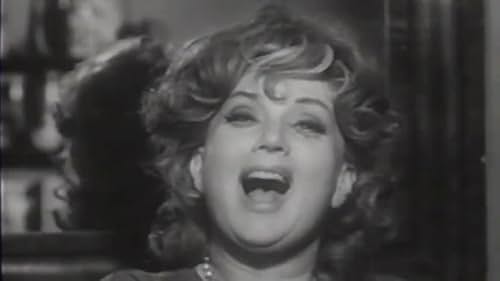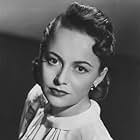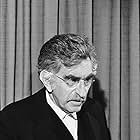IMDb RATING
6.7/10
3.9K
YOUR RATING
A woman trapped in a home elevator is terrorized by a group of vicious hoodlums.A woman trapped in a home elevator is terrorized by a group of vicious hoodlums.A woman trapped in a home elevator is terrorized by a group of vicious hoodlums.
- Director
- Writer
- All cast & crew
- Production, box office & more at IMDbPro
Storyline
Did you know
- TriviaFirst of two pictures in a row in which Olivia de Havilland stepped into a role originally announced for Joan Crawford. She also replaced Crawford in Hush...Hush, Sweet Charlotte (1964).
- GoofsThe battery for the alarm is shown as it runs down; but later in the movie the battery works like new.
- Quotes
Cornelia Hilyard: You're one of the many bits of offal produced by the welfare state. You're what so much of my tax dollars goes to the care and feeding of!
- Crazy creditsThe opening Paramount logo is done in vertical stripes to reflect the cage motif.
- ConnectionsFeatured in What She Said: The Art of Pauline Kael (2018)
Featured review
Olivia de Havilland looks a little uncomfortable in this shocker, a debut feature from a director who had previously worked in TV suspense shows (including 'The Untouchables', also criticised for its violence). Not only does she have to perform for most of the film from a lift cage, but has to contend with a purple script, and participate in scenes of violence and degradation entirely alien to her screen persona to date.
This is a film angry and ugly in equal measure. Jet planes fly overhead unconcernedly as Mrs Hilyard is tormented, just as cars have already driven past blind to the dead dog laying outside her house. A young black girl runs her skates up the injured legs of a fallen drunk. Women are either helpless (Hilyard), nympho druggies (Elaine) or faded whores (Sade). Men are drunks (Brady), mummy's boys (Malcom) or worse. It is a world full of indifference to the plight of others, of strangers who are casually cruel, of heat, claustrophobia and malice. Mrs Hilyard herself does not deserve her ordeal, but her snobbery (and self satisfied addiction to appalling verse, principally of her own composition) and expressed distate for the "offal of the welfare state" is hardly attractive. Clearly Grauman intends her predicament to be an allegory both of her personal and social isolation as Hilyard's experience occurs amidst an ominous backdrop of current events (at one point she thinks the bomb has dropped). Now and again the world intrudes through a broadcast or passing plane which places the action in a larger context. This of course is lost on Mrs Hilyard. She is just as much out of touch with with society at large as with her son's emotions. Ultimately her captivity by the Randall gang is merely a physical realisation of what, morally, has long been the case. There's a shot which emphasises this: the masked Randall, Elaine and Essie stare fixedly at Mrs Hilyard over the banisters. The camera pans over from their silent and still faces to the victim's, then over to the window through which the sun appears as a burning globe. Their presence it seems is a permanent, and as harshly pervasive as elements of nature.
This was Caan's debut, and his is quite a presence, stalking panther-like, around the looted home. His sadism and shallow greed, and complete lack of redeeming features, make the greatest impact in a film which is full of such gestures. When burping his contempt for his captive, Caan expresses in a few uncouth noises ("I *am* an animal" he proudly confesses at one point) more than much of the other speechifying put together. The ironic equivalent of Hilyard's poetry, his grunts sum him up as neatly as Mrs Hilyard's affected and dated poeticism does her.
Paul Glass' score is a standout and makes for a stunning opening titles sequence. Its discordance and violence reflecting exactly the film's aggressive, alienated tone - one which, as has been noted by other viewers, anticipates that of 'Clockwork Orange' a few years later. Interestingly during the titles the director's credit appears on a conditioning unit, as if he intends his work to let some fresh air in on the foulness he will uncover. Whether or not he succeeds is up to the viewer to decide, but it doesn't make for an easy ride, and one banned in Finland and Australia. Interestingly his next film was the much more restrained and conservative '633 Squadron' until after a couple more obscure films he retreated back to TV.
This is a film angry and ugly in equal measure. Jet planes fly overhead unconcernedly as Mrs Hilyard is tormented, just as cars have already driven past blind to the dead dog laying outside her house. A young black girl runs her skates up the injured legs of a fallen drunk. Women are either helpless (Hilyard), nympho druggies (Elaine) or faded whores (Sade). Men are drunks (Brady), mummy's boys (Malcom) or worse. It is a world full of indifference to the plight of others, of strangers who are casually cruel, of heat, claustrophobia and malice. Mrs Hilyard herself does not deserve her ordeal, but her snobbery (and self satisfied addiction to appalling verse, principally of her own composition) and expressed distate for the "offal of the welfare state" is hardly attractive. Clearly Grauman intends her predicament to be an allegory both of her personal and social isolation as Hilyard's experience occurs amidst an ominous backdrop of current events (at one point she thinks the bomb has dropped). Now and again the world intrudes through a broadcast or passing plane which places the action in a larger context. This of course is lost on Mrs Hilyard. She is just as much out of touch with with society at large as with her son's emotions. Ultimately her captivity by the Randall gang is merely a physical realisation of what, morally, has long been the case. There's a shot which emphasises this: the masked Randall, Elaine and Essie stare fixedly at Mrs Hilyard over the banisters. The camera pans over from their silent and still faces to the victim's, then over to the window through which the sun appears as a burning globe. Their presence it seems is a permanent, and as harshly pervasive as elements of nature.
This was Caan's debut, and his is quite a presence, stalking panther-like, around the looted home. His sadism and shallow greed, and complete lack of redeeming features, make the greatest impact in a film which is full of such gestures. When burping his contempt for his captive, Caan expresses in a few uncouth noises ("I *am* an animal" he proudly confesses at one point) more than much of the other speechifying put together. The ironic equivalent of Hilyard's poetry, his grunts sum him up as neatly as Mrs Hilyard's affected and dated poeticism does her.
Paul Glass' score is a standout and makes for a stunning opening titles sequence. Its discordance and violence reflecting exactly the film's aggressive, alienated tone - one which, as has been noted by other viewers, anticipates that of 'Clockwork Orange' a few years later. Interestingly during the titles the director's credit appears on a conditioning unit, as if he intends his work to let some fresh air in on the foulness he will uncover. Whether or not he succeeds is up to the viewer to decide, but it doesn't make for an easy ride, and one banned in Finland and Australia. Interestingly his next film was the much more restrained and conservative '633 Squadron' until after a couple more obscure films he retreated back to TV.
- FilmFlaneur
- Jan 24, 2002
- Permalink
- How long is Lady in a Cage?Powered by Alexa
Details
- Release date
- Country of origin
- Languages
- Also known as
- Diez horas de terror
- Filming locations
- 1132 South Lake Street, Los Angeles, California, USA(exterior view of Mrs. Hilyard's house)
- Production company
- See more company credits at IMDbPro
Box office
- Budget
- $500,000 (estimated)
- Runtime1 hour 34 minutes
- Color
- Aspect ratio
- 1.85 : 1
Contribute to this page
Suggest an edit or add missing content































